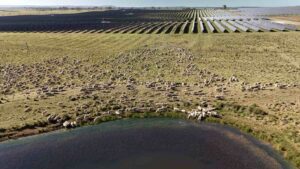The head of one of Australia’s biggest electricity networks says he sees no long-term future for large, centralised electricity generators, nor for big electricity retailers.
Rob Stobbe, the CEO of SA Power Networks, says both business models will be made redundant – the generators by the increased use of localised, mostly renewable generation, and the retailers because, well, they just won’t be needed any more.
Stobbe’s remarks, made at the company’s investor day presentation last week, challenges the bedrock of Australia’s electricity network – which is dominated by three big “gentailers” – Origin Energy, AGL Energy and EnergyAustralia – who combine the two very services Stobbe says will no longer be needed.
It also shapes up as an intriguing power play between the network operators who deliver the energy services, and the retailers who deal directly with the customers. Now that consumers are being empowered with solar and storage, and becoming “prosumers” in their own right, the dynamics and the services they need are changing. They may even be able to trade their own electricity.
Stobbe’s theory is that solar PV uptake will increase dramatically – even from its current level of one in four houses – and so too will battery storage as its costs follow solar down the cost curve. Networks will be still be required, however, to move the electrons around between homes and communities, and from individual and collective storage devices.
SA Power Networks, like Ergon Energy in Queensland, and Horizon Power in WA, is currently looking at using battery storage to replace poles and wires and to encourage more local renewable generation. For the moment, this is being done for the sake of reliability – poles and wires carrying electrons from centralised coal fired power stations are prone to damage from winds and fire, and can no longer be relied upon.
But it is also becoming rapidly more economic – as well as more reliable – to use solar and storage to establish micro-grids; first in areas that compete with diesel fuels, and within a few years in regional towns. Inevitably, as the technology is deployed, this will also be the case in larger towns and cities.
“We will have a totally new business model going forward,” Stobbe told analysts during the presentation. “There is no doubt about that. We just need to be part of it.”
Asked by analysts about the future role of networks in a decentralised grid, Stobbe said: “I’d be more concerned about the generators and the retailers and what their future is. They don’t have one.”
He continued: “At least we have got the network that can be utilised in micro grid environments. It is easier for us to move into that environment. A lot of people still don’t believe it will happen. We think it is a long way off, but we may be proved wrong.”
Stobbe says that the power, so to speak, will lie with those entities that “own” the data. “They will be the ones that own the future,” he says. And, he notes, networks are a more trusted source of information, advice and service than retailers. “They (the retailers) are not highly regarded,” he said. “We are trusted. They (the customers) know we will be here in another 20, 30, 40 years.”
Stobbe’s remarks are based on predictions that the uptake of solar, storage, and even electric vehicles, will be dramatic. As we reported last week, and see table above, it expects 70 per cent of customers to have solar and 50 per cent to have storage within two decades. The economics of grid disconnection will fall rapidly, first in regional areas, and then in more built up areas. (See graph below to the right).
Stobbe says it will make sense for consumers, even communities, to go off grid, especially in remote areas.

Then, others in urban and rural areas will also defect, because they like the idea of renewables and independence. And “no doubt over time”, Stobbe says, some residential developments and communities will either go off totally or use the local grid or a “thin grid” to assist in moving energy around that development or community.
The trick for network operators is how they manage this. SA Power Networks, as we reported on Monday, is to trial a micro-grid in regional areas, although it has yet to decide on the location.
“In the next 5 years, we are just preparing ourselves in terms of this new future coming towards us,” Stobbe says.
“If you think about what people are putting in, whether it is solar PV and or storage,” Stobbe says, the distribution network is a very useful tool – to export excess into grid and get some revenue, or to share power between consumers.
“We believe there is a long-term benefit and value in terms of the grid. We are just positioning ourselves to ensure we can play in that market.”
It could happen a lot quicker than that, were it not for the massive cross-subsidy paid by city folk to people living in regional areas. SA Power Networks estimates that 70 per cent of its grid costs are to service just 30 per cent of its customers – but the costs are share equally. Regional customers in Queensland and Western Australia are also subsidised by the government, or other users, to the tune of $1.2 billion a year.
Stobbe was asked by one analyst if his scenario meant that SA Power Networks would end up competing head on with the likes of AGL Energy and Origin Energy.
Stobbe sad: “You can be a retailer without being a retailer, it depends on the how micro grid is set up. Who says that you need retailer at all, if you have community willing to share energy among houses. We just provide a charge for that network.”
As an example, he suggested customers could pay $15 a week for that network, and that is all thy would have to pay – apart from the cost of installation of their own solar and storage. “They could get rid of 70% of costs and have us as provide distribution for $15 a week. That’s not bad. Economically, that makes sense for consumers.
“Do you need retailers in the future? I doubt it.”











